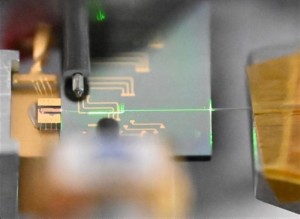
Dr. Qiushi Guo of CUNY has demonstrated a novel approach for creating high-performance ultrafast lasers on nanophotonic chips. His work is focussed on miniaturizing mode-locked lasers – unique lasers that emit a train of ultrashort, coherent light pulses in femtosecond intervals, a quadrillionth of a second.
The high-speed, pulse-peak intensity, and broad-spectrum coverage of mode-locked lasers is necessary for the study of extremely rapid timescales, such as the making or breaking of molecular bonds during chemical reactions, or light propagation in a turbulent medium. Mode-locked lasers have also enabled various photonics technologies, including optical atomic clocks, biological imaging, and computers that use light to calculate and process data. They are, however, expensive and power-demanding, and use tabletop systems that are limited to laboratory use.
“Our goal is to revolutionize the field of ultrafast photonics by transforming large lab-based systems into chip-sized ones that can be mass produced and field deployed,” said Guo, a faculty member with the CUNY Advanced Science Research Center’s Photonics Initiative and a physics professor at the CUNY Graduate Center. “Not only do we want to make things smaller, but we also want to ensure that these ultrafast chip-sized lasers deliver satisfactory performances. For example, we need enough pulse-peak intensity, preferably over 1 watt, to create meaningful chip-scale systems.”
Guo’s research utilizes an emerging material platform known as thin-film lithium niobate (TFLN). TFLN enables very efficient shaping and precise control of laser pulses by applying an external radio frequency electrical signal. Guo’s team uniquely combined the high laser gain of III-V semiconductors and the efficient pulse shaping capability of TFLN nanoscale photonic waveguides to demonstrate a laser that can emit a high output peak power of 0.5 watt.
In future, the team will address realizing scalable, integrated, ultrafast photonic systems that can be translated for use in portable and handheld devices.
“This achievement paves the way for eventually using cell phones to diagnose eye diseases or analyzing food and environments for things like E. coli and dangerous viruses,” Guo said. “It could also enable futuristic chip-scale atomic clocks, which allows navigation when GPS is compromised or unavailable.”
